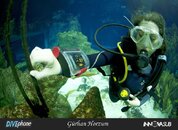RonR
Contributor
"practical distance" could also have different definitions. As an example practical distance could be few millimeters (0.1") ..... the thickness of an underwater housing. In this scenario, as long as there is no salt water in the middle, 2.4GHz works fine and you could add depth information to a smartphone. Nothing magic ... just laws of physics (well, a bit of magic is indeed present ... in the modern semiconductor devices implementing wireless communication standards.)
Thank you for mentioning our bluebuddy wireless datalogger device
Alberto (aka eDiver)
---------- Post added March 17th, 2013 at 08:17 AM ----------
That would NOT work!
In our calculations (and real life testings), the max usable "water gap" is few (very few) millimeters for salt water and a bit more for fresh water.
Alberto (aka eDiver)
Yep, that's what I meant above by "physically attached". High frequency RF attenuates very rapidly in water, and extremely rapidly in salt water. This question comes up frequently- and it's not unreasonable, since people are used to using so many wireless devices. Unfortunately, like many things underwater, it's just not that easy.
Even what is considered low frequency in general use- 433MHz- we have gotten to transmit only a few feet in fresh water, and inches in salt, at least at portable type power levels. Bluetooth or WiFi, being much higher frequencies, will only work if essentially attached. It's not that it wouldn't be possible to talk to a Pebble watch underwater, but the design constraints are significant.
Ron





